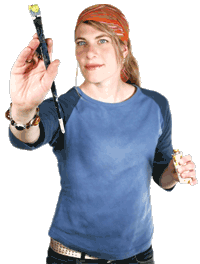At WiseGEEK, we're committed to delivering accurate, trustworthy information. Our expert-authored content is rigorously fact-checked and sourced from credible authorities. Discover how we uphold the highest standards in providing you with reliable knowledge.
How is Batik Fabric Made?
Batik fabric is made with a wax resist technique, where wax is applied to the fabric prior to dyeing to limit the areas where the dye can penetrate. To make multicolored fabrics, multiple applications of wax and dye may be used to achieve the desired outcome. While modern mass-produced batik fabric is often made with the assistance of stamps and printers, traditional batik made with hand drawn patterns is still available, and is known as batik tulis.
Wax resist techniques appear to be ancient. Fabrics produced using this method have been found in regions like Egypt and China, and some specimens are very old, while documentation of the process is even older. Batik, most closely associated with Indonesia, became very widespread after the 18th century. Many other Asian nations including Thailand and Malaysia also produce batik fabrics.

For a traditional batik tulis, the craftsperson uses a stylus known as a canting. It includes a needle attached to a small reservoir for warm wax, with a wooden handle. The needle is periodically dipped into a larger pot of hot wax, and depending on how wide the opening is, it can be used to draw anything from thick lines to very small dots. The fabric usually needs to be prepared ahead of time to remove any chemicals left over from processing, and cotton and silk are preferred, as they take dyes well.
Regional batik fabric production techniques may incorporate a variety of colors, ranging from somber browns and creams to more vivid colors. The patterns are also traditional, and historically carried important meanings. Some prints were reserved for certain social classes and in regions where Islam became predominant, batik fabric patterns are usually abstract or contain flowers, complying with the ban on depicting living figures in art.
For mass production, stamps and printing devices may be used to apply wax, and some producers don't use the wax resist technique, preferring other methods for generating printed batik patterns. Traditionally produced batik fabric can be quite costly, as it can take a very long time to make, especially in the case of fabrics finished with gold. Some very fine examples of traditional fabrics can be seen on display at museums and are sometimes used at cultural events like demonstrations of traditional dance. Dancers may be happy to share information about the origins of their garments and can provide more details on the pattern of the fabric and its meaning.
AS FEATURED ON:
AS FEATURED ON:










Discussion Comments
@hamje32 - You don’t have to import the Batik from Indonesia if you want to use Batik fabric for your own designs. There are Batik fabric stores online you can go to where you can get different design patterns, at decent prices.
I don’t know if they have exactly what you saw that girl wear, but I do know that the patterns and colors are quite varied from what I’ve seen. I don’t believe these Batik fabrics are imported. Rather they make them in the United States but use the waxing processes described in the article.
@miriam98 - I love the Batik fabric and designs. A few years ago I attended a Christmas cultural festival where we saw dancing and singing from people of different ethnic origins, all dressed in their native attire.
The most beautiful of the bunch, in my opinion, was a young girl who came out, dressed in this floral, flowing Batik dress and performing what was called a “Peacock” dance. It was a Balinese dance and she was absolutely stunning in her performance.
In talking with her afterwards she told me that the dress she wore was imported from Indonesia, and it was as authentic as anything I had ever seen. It was royal gold, interspersed with pink laces. It looked like a million dollars, and she wore it well.
I actually own Indonesian Batik fabric myself. I lived in Indonesia for several years and Batik is very popular over there. I have several Batik shirts that I wore to various social functions while living overseas.
An interesting item to note is that these shirts are not meant to be tucked in, but worn as kind of mini jackets. In fact, in Indonesia Batik shirts are an acceptable alternative to business suits! I’ve been at several functions where I saw some men dressed in business suits and some in Batik shirts, and they were all considered dressed appropriately for the occasion.
Now and then I’ll wear a Batik shirt to a function here in the United States, and it does draw attention, because the unique designs are somewhat “loud” by contemporary standards. Still, I turn it into an interesting conversation piece.
Post your comments